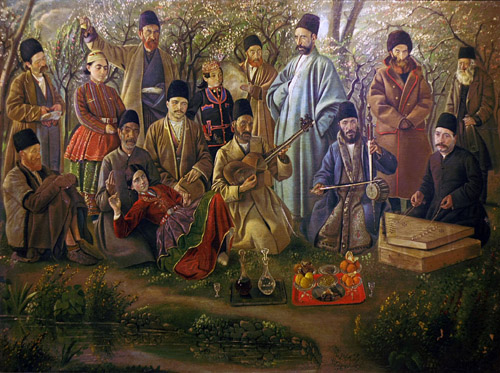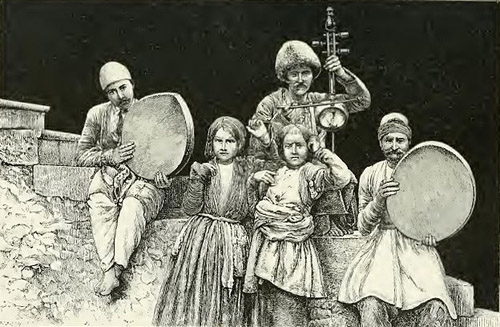
A Survey on History of Innovation in MusicNetIran April 11, 2004 By : Dr. Sassan Sepanta A glimpse at the history of the current century seems to be indispensable to a survey on innovations taken place in the original Iranian music. The outset of modernization of Iranian music almost coincided with the growing trend of communication with Europe. By the end of Fat'h-Ali Shah Qajar's reign, such communication kept growing. The arrival of European music experts and consulting delegations in Iran prepared the grounds for impressing Iran's culture and art. In particular, dispatch of growing number of students to France and other European countries, during the rule of Nassereddin Shah Qajar, facilitated development and innovation in literature, painting, music, architecture and other art fields. The Iranians were well familiar with European literature, given that they had been translating the works of European writers into Persian. Besides publishing newspapers and freedom-seeking thoughts towards the end of Nassereddin Shah's era were also effective in the development of the community's thinking trend. 1st Effective Steps Taken towards Innovation of Iranian Music -- Establishment of Dar-ol-Fonoun School in 1851 was actually a turning point in Iran-Europe cultural relations. Major changes took place in the traditional teaching method in Dar-ol-Fonoun school and, where teaching European sciences and techniques became common so far as the conditions allowed. On the other hand, a number of foreign teachers, specially French, arrived in Iran at the government's invitation to teach there. Therefore, when in his third trip to Europe Nassereddin Shah observed that musical groups particularly those specialized in martial music played the national anthem of their country and marsh music, he ordered to employ the French musician Alfred Jean Baptiste Lemaire and he started teaching martial music in Dar-ol-Fonoun. After his arrival in Tehran in 1868, he started teaching martial music. This was the first time ever that martial music was being taught according to organized principles and by using internationally used written notes. Under the supervision of Lemaire, the students majoring in music started to learn the basics of European music, notes and playing wind instruments as well as other instruments such as piano.  Besides Lemaire composed Masoud marsh and Isfahan Polka. He also rearranged a number of old songs for orchestra. They were performed by Dar-ol-Fonoun orchestra and Lemaire himself conducted it. The performed pieces have been gradually broadcast through radio programs over the past 30 years. Lemaire's musical group known as Monarchial orchestra, used to play during official ceremonies, ceremonial feasts such as Norouz (the New Iranian year starting March 21) most often held at Golestan palace at the presence of Nassereddin Shah and the passion plays arranged by the government. Thus, playing short European melodies became common in Iran through time. Also Iranian songs were written and sung. After the demise of Lemaire in 1909, the general music branch was separated from marshal music and a music school was established. Gholam-Reza Khan Salar Moazzez, who had studied music at Saint Petersburg Music School, started teaching music there. In addition to teaching, Salar Moazzez arranged musical pieces including marshes and fantasy music in the division of notes known as Isfahan to be played in accompaniment to piano. His trainees were gradually introduced to some of the European instruments and started playing short pieces from Beethoven and Tchaikovsky among others. Condition of Music of the Period -- Up to the period, players of Iranian traditional music, among whom Mirza Abdollah and Aqa Hossein-Qoli were the most famous, continued to follow the old style of seven major divisions of the Persian tunes. They hardly made any changes either in the common structure or performance of Iranian music. Meanwhile, music was mostly performed in private. The political and social developments taking place towards the end of Nassereddin Shah's reign and the early days of Mozaffareddin Shah, the growing trend of publication of newspapers, promotion of freedom-seeking thoughts, issuance of the Constitution decree in 1906 as well as Mohammad Ali Shah's intrigues and failure in fulfilling his commitments to proponents of Constitution led to a movement aiming to campaign against despotism. Meanwhile, formation of numerous associations and freedom-seeking groups paved the way for gatherings and holding concerts. Figures Oriented towards Seeking Development -- In this period, one of the players of tar, Gholam-Hossein Darvish (1892-1926), who had been trained on playing drum and trumpet in Dar-ol-Fonoun as a child and was later given lessons on tar by Aqa Hossein-Qoli, managed to compose a number of songs, melodies and preludes and started writing new pieces of Iranian music. This was an unprecedented measure. His good taste and acquaintance with the European musical meters he had learned at Dar-ol-Fonoun Music School were the assets which helped him to improvise and make such pieces as Darvish Polka and the Republic Marsh. In writing Polka in two tempos quite similar to a Russian dance, he made a modal change in the division of Persian notes from Mahour to quadruple, which was improvised by him for the first time ever. He was the one who added one more cord to tar, which until then consisted of five. One of the impacts of the campaigns of freedom-seekers was the changes taking place in the content of melodies to national-patriotic themes including campaign against atrocity, lauding courage and the militants sacrifice. One of the impacts of such movements was to release the musicians and singers from the influence of aristocracy. For several centuries, the social conditions and the policy of dictatorial governments in Iran had been such that the players of music and singers most often had to seek the sponsorship of a powerful ruler in order to secure earning their lives and protect themselves against the biased believes of the general public. The exercise was common up to the past century. After the World War I (1293-1297), the players of Iranian traditional music continued their common style. Meanwhile, the modernists took on seeking new ways to create some variety in Iranian music and managed to produce a number of modern pieces. In that time, several musical plays were written and staged such as "Monarchs Resurrection" by Seyed Mohammad Reza Mirzadeh Eshqi (1894-1924). It was staged several times. The playwright was inspired by Aziz Hajji Beikov's melody called "Leili & Majnoun".  Figures Remembered for their Innovations in Iranian Music -- The measures taken to this point prepared the grounds for effective modernization of Iranian music. In 1923, Colonel Ali-Naqi Vaziri returned home from Europe. Before leaving for Europe, Vaziri (1887-1979) learned playing tar, writing musical notes and basics of European music. He managed to write notes for Aqa Hossein-Qoli's musical compositions. Once he left for Europe, spent five years in France and Germany to complete his studies in music. He was intent to modernize Iranian music after returning to Iran. In February 1923, he established the Higher Institute of Music to this same end. A year later, he also founded a music club, where he arranged concerts performed by the school orchestra. They consisted of the melodies he had composed in an innovative style in line with his major objective of innovation. He also staged a number of his operettas including "Golrokh" and "A Pessimist Husband" as well as dramas sucháas "The Misfortunate Girl" and "Separation" among others. In 1925, Vaziri expressed his views and objectives by issuing four handouts, in which he said that concerts and plays are not only aimed for pleasure, but that they are meant to introduce art to the people, as a means nurturing their spirit." He added, "If we ever had access to practical ways of gaining knowledge on the major arts and know-how on developing our minds, we too could have competed with the world civilized nations in no time."Japan is a developed nation which has materialized such a goal in the past 40 years (meaning 40 years before 1925, when Vaziri made such a remark)." He concluded that music in Iran is one of the arts, which has been undermined by lack of facilities and scientific knowledge. Vaziri was initiative in a lot of musical fields. He had written a number of expressive pieces called "Musical Tableaux", which were quite unique and unprecedented in Iranian music. "Kerman Rug", "Midnight" based on one of the lyrics of Hafiz are two examples. His modernátunes include "My Daughter's Dance" and "The Waltz of Two Fiancés" among others. In 1928, Vaziri founded Women's Club and women's exclusive cinema which were closed shortly! After he was appointed as the head of the state Music School, he continued to follow his modernistic objectives. He believed that as a beginner, the music trainees should be introduced to the core of European music both in playing instruments and theoretical studies. When it came to playing an instrument, he gave priority to starting with European musical styles, while using the self-instruction books he himself had compiled on playing tar and violin simultaneously. The pieces he had written for tar and had already been played and recorded on gramophone were quite unique in composition, interval, meter and playing technique. He was quite creative in the orchestra instrumentation, improvising new instruments such as the soprano tar, alto tar, bass tar as well as coordinating and developing contre pointe in his melodies. áUsing the female and male voices simultaneously in several pieces including "Heaven's Tyranny", "By the Garden" and "The Friend and Crying Heart". He also had his own particular style in writing melodies including "Your Enthusiast", "Drunk Nightingale", "Forlorn", "Sinister Symphony" written on the occasion of his father's demise, "Caravan" and "Oil Symphony" marking the nationalization of oil industry as well as composing songs exclusively for schools, the youth and children. The impression of Vaziri's modernist school on a number of music players and singers was unavoidable. Ismail Mehrtash, a tar player and musician, established Jame'eh Barbod in 1926, where operettas such as "Leili & Majnoun", "Khosrow & Shirin" as well as "Khayyam" were stages. Gramaphone records on some of his operettas and melodies also came out, which similar to Vaziri's works were distributed across the country. At this time, some musical plays including Mirzadeh Eshqi's "Monarchs Resurrection" were sung by celebrated singers such as Qamar-ol-Molouk-e Vaziri its records were also produced. Qamar has told the writer of this article that she had sung the piece as she very gruesome and upset over the death of a love. According to her, the song had been based on the poems written by the gallant poet. Another available record is a song sung by Seyed Javad Badizadeh, whose tune had been written under the influence of European dances such as waltz.
|